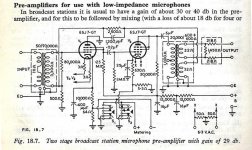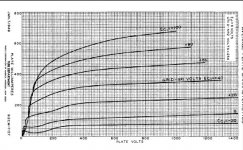rongon,
Were you able to get the LTP cathode coupled 5687 to drive the 2A3 tubes grids fully.
(With the grid voltage the same as the elevated filament "cathode" voltage (0 Volts g-f, g-"k")?
A long tailed 5687 splitter will always have gain that is less than 1/2 of u (</= 50% of u).
u = 17,
17/2, gain = 8.5.
Just my opinion.
Were you able to get the LTP cathode coupled 5687 to drive the 2A3 tubes grids fully.
(With the grid voltage the same as the elevated filament "cathode" voltage (0 Volts g-f, g-"k")?
A long tailed 5687 splitter will always have gain that is less than 1/2 of u (</= 50% of u).
u = 17,
17/2, gain = 8.5.
Just my opinion.
What was your objective for that exercise with the 4-65A? Did you use it as an amp or other application?PRR,
Yes, in a tetrode, the screen can act as a plate.
But only if you either disconnect the plate, or connect the screen and plate together.
I built an amplifier with a 4-65A, a real tetrode, for those who may not know a 6L6 is not a tetrode (not you PRR).
I connected the 5k output transformer to the 4-65A screen. The plate was left disconnected.
Even when the output current was tested at the B+ voltage of about 390V, tying the plate to the screen did not significantly increase the output current. That tube really wants the plate voltage to be 2X, 3X, or more Volts than the screen voltage.
I used an ECC99 driving a 1:1 interstage transformer to drive the 4-65A.
The screen current was adjusted by the self bias resistor so that the screen voltage x the screen current gave 10 Watts screen dissipation,
(its maximum rating).
With the plate disconnected, the plate was cold (not dissipating its 65 Watt rating) and so the cold plate did not add to the screen heating; keeping the screen very safe at its 10 Watt rating.
For safety, the plate was grounded, so grabbing the plate cap was safe and OK.
Yes, in my special case amplifier, the 4-65 screen acted exactly like a "plate" when the plate was disconnected.
But if I had much higher B+, and had only the plate driving the 5k output, plus if I had the screen connected to a constant voltage supply (as the 4-65A was designed for), then the screen would no longer act like a plate, its screen current versus grid 1 voltage and plate voltage would be different, versus the way I used in in my amplifier.
In the true Tetrode application, the screen current curves would look entirely different than it did with the plate disconnected (as when I "improperly" used the 4-65A).
The above are my opinions (and my experience too).
The 4-65A curves look very pentode like even at low voltage. The designers must have carefully
read Owen Harries 1935 paper on the Critical Distance Tetrode.
Many years ago I tried a screen RC circuit I found buried in RDH4 as a low level amp.
The plate of the 6SJ7 is grounded, the audio signal taken off the screen.
Worked well & interference pickup was very low.
Attachments
jhstewart9,
Good question! Why did I use the 4-65A in such an unusual manner?
Thanks for asking.
I designed and built a stereo 45 amplifier for one of the VSAC events in Silverdale, Washington. Each channel had a parallel ECC99 driving a 1:1 interstage, and that drove the 45 tube. It sounded good Wednesday night, and 2:00 AM Thursday too. I turned the amp off.
At 10:00 AM Thursday, I turned the amp on for another listen.
One of the 45 tubes went gassy and became a relaxation oscillator (it sounded horrible). I did not have any other 45 tubes.
I liked the looks of the 4-65A. The screen dissipation was the same 10 Watts as the plate dissipation of the 45.
But everything else was different, filament voltages and currents, B+ voltage for optimum operation (4-65A screen can be used at 600V), and the output transformer of 4.8k was really too low for the 4-65A.
There was virtually no plate current (plate and screen connected together, the screen got all the current, because the B+ voltage was way lower than normal 4-65A plate voltages, and the plate so far away from the screen).
So, I grounded the plate.
But I wanted to bring an amplifier to VSAC. I decided to modify to use the 4-65A tubes somehow.
I had to change the filament supplies. I did not have the parts or time to do anything else. I had to re-build, and then drive to VSAC.
Even knowing that the output power would be extremely low, I did it for the looks. It worked fairly well, considering.
And the grounded plate was visible, and a real conversation starter.
VSAC was always fun!
Yes, when the 4-65A used as a true tetrode . . . the plate curves look very similar to pentode and beam power plate curves.
But at least to me, used as a true tetrode, they do not look like triode curves.
Good question! Why did I use the 4-65A in such an unusual manner?
Thanks for asking.
I designed and built a stereo 45 amplifier for one of the VSAC events in Silverdale, Washington. Each channel had a parallel ECC99 driving a 1:1 interstage, and that drove the 45 tube. It sounded good Wednesday night, and 2:00 AM Thursday too. I turned the amp off.
At 10:00 AM Thursday, I turned the amp on for another listen.
One of the 45 tubes went gassy and became a relaxation oscillator (it sounded horrible). I did not have any other 45 tubes.
I liked the looks of the 4-65A. The screen dissipation was the same 10 Watts as the plate dissipation of the 45.
But everything else was different, filament voltages and currents, B+ voltage for optimum operation (4-65A screen can be used at 600V), and the output transformer of 4.8k was really too low for the 4-65A.
There was virtually no plate current (plate and screen connected together, the screen got all the current, because the B+ voltage was way lower than normal 4-65A plate voltages, and the plate so far away from the screen).
So, I grounded the plate.
But I wanted to bring an amplifier to VSAC. I decided to modify to use the 4-65A tubes somehow.
I had to change the filament supplies. I did not have the parts or time to do anything else. I had to re-build, and then drive to VSAC.
Even knowing that the output power would be extremely low, I did it for the looks. It worked fairly well, considering.
And the grounded plate was visible, and a real conversation starter.
VSAC was always fun!
Yes, when the 4-65A used as a true tetrode . . . the plate curves look very similar to pentode and beam power plate curves.
But at least to me, used as a true tetrode, they do not look like triode curves.
Last edited:

